Grill Guide: Master the Art of Grilling

Do you use your grill to its fullest in summer? Grilling is more than cooking. It’s an art that blends skills, taste, and fun outside. This guide will show you top grilling tips. You’ll learn to use your grill like a pro.
About 64% of U.S. homes choose gas grills for ease and speed. Gas grills cost between $200 to $1,500. They heat up fast and keep the heat steady. Whether you’re new or experienced, knowing your grill and tools can improve your skills.
Picking a grill is just the start. It’s important to master grilling techniques like marinating rightly and heating up correctly. Doing so stops issues like cooking unevenly. Also, looking after your grill well can make it last 10 years longer. Ready to make your grilling events amazing?
This guide walks you through all you need to know. It covers safety, how to season, and new ways to grill. Whether you love juicy meats or crisp veggies, this guide is here to help you shine.
Your journey from a grill fan to Grill Master begins now. Every recipe and technique you learn brings you nearer to being great at cooking outside.
Understanding Different Types of Grills
Picking the right grill depends on your lifestyle, what you like to cook, and where you’ll use it. There are gas, charcoal, and electric grills, each with its pros and cons. These fit different grilling styles and needs.
Gas Grills: Convenience and Efficiency
Gas grills are great for those who value quick and easy cooking. They heat up fast, reaching temperatures between 400 and 600 degrees Fahrenheit. This range is great for most meats and veggies. A 20-pound propane tank lasts for about 25 hours of grilling. You can also quickly change the temperature to get the perfect cook every time.
Charcoal Grills: Traditional Flavor and Technique
Charcoal grills are best for the smoky taste fans. They get really hot, up to about 700 degrees Fahrenheit, which is perfect for searing steaks. But, they take more work and skill. They need 15 to 20 minutes to warm up, and cleaning involves getting rid of charcoal ash. Yet, many people love the taste and fun of using them.
Electric Grills: Indoor Options for Every Home
Electric grills are great if you can’t have open flames, like in apartments. They work well inside, so you don’t need a yard or patio. But, you need to be near an outlet to use them. They’re easy to use and make indoor grilling possible for city folks. However, these grills usually have less space for food.
| Grill Type | Max Temperature | Special Features |
|---|---|---|
| Gas Grills | 400-600°F | Quick preheat; Easy temperature control |
| Charcoal Grills | Up to 700°F | Authentic smoky flavor; Requires skill |
| Electric Grills | Varies | Indoor-friendly; Limited to outlet proximity |
Essential Grilling Tools for Every Enthusiast
To grill like a pro, you need top tools. With the right accessories, your cookouts will shift from good to great. Let’s talk about the main tools, finding the perfect grill cover, and why a meat thermometer is key.
Must-Have Utensils and Accessories
A true grill master needs the best tools. You’ll want long tongs, a strong spatula, and gloves that can handle up to 932°F. Get tongs that are 16 inches long to keep your hands safe from the fire.
- Grill Tool Set: $32.98
- Basting Pot and Brush: $27.99
- Grill Basket for Vegetables: $30.30
- Copper Grill Mats: $7.99
- Grill Caddy: $34.99
To control your grill’s heat well, use a Weber Rapidfire Chimney Starter. It gets your charcoal ready in a bit over 24 minutes. A Thermoworks meat thermometer gives you temperatures fast, in one second.
Choosing the Right Grill Cover
Keep your grill safe with a good cover. A sturdy cover keeps it in great shape for more cooking. Choose a cover made of materials that last and protect against weather.
“Investing in a quality grill cover can significantly extend the life of your grill by protecting it from harsh weather conditions.”
Importance of a Good Thermometer
A meat thermometer makes sure your food is just right. It helps you avoid over or under cooking. The Thermoworks thermometer is tough, keeping up through many grilling days.
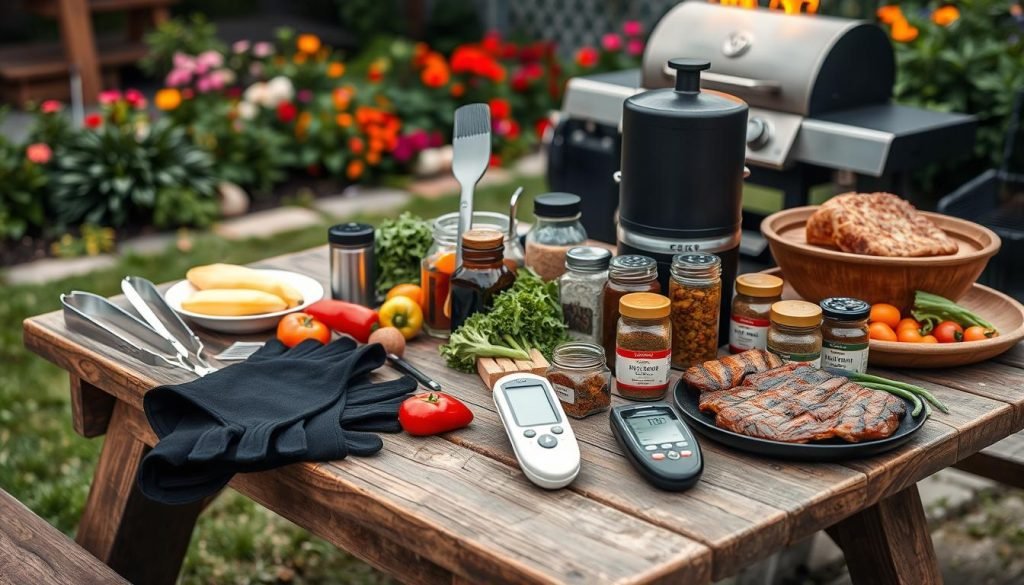
| Product | Price | Key Feature |
|---|---|---|
| Thermoworks Quick-Read Meat Thermometer | $99.95 | Reads in 1 second, shockproof |
| Weber Rapidfire Chimney Starter | $69.99 | Ensures coals turn fully ashy in 24 minutes |
| Grill Gloves | $24.95 | Heat resistance up to 932°F |
Having these essential tools will make your grilling better. Every barbecue will be a hit.
Preparing Your Grill for Cooking
Want a great BBQ? Start with a clean, hot grill. Cleaning and heating it right makes food taste better. Here’s how to clean and preheat your grill the right way.
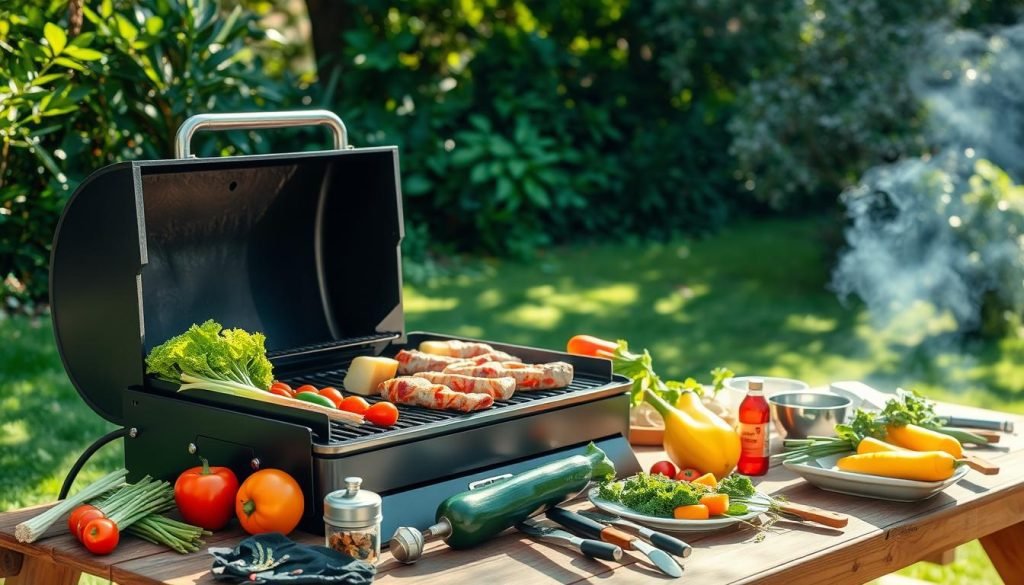
Cleaning Your Grill: Steps to Follow
Old flavors on your grill can ruin new food. Start by heating your grill for 7-10 minutes. This loosens old gunk. Then, use a strong metal brush for cleaning grills. Scrub the grates well to get rid of burnt bits. Use a wooden scraper too, so there are no metal pieces left.
- Heat the grill for 7-10 minutes.
- Use a firm metal bristled brush to scrub the grates.
- Inspect and clean with a wooden scraper.
- Apply vegetable oil using long-handled tongs to create a semi non-stick surface.
Don’t just use a wood scraper. It’s not as good as a metal brush. Cleaning keeps your grill safe and makes food taste better.
Preheating Techniques for Best Results
Heating your grill right is key to good cooking. For gas grills, heat for 10-15 minutes. Charcoal grills heat faster because they’re hotter. Warm grates stop food from sticking, helping with fish or veggies.
“High heat alone is not sufficient for effectively sanitizing grill grates. Proper preheating time (10-15 minutes) is crucial for bacteria elimination.” – U.S. Department of Agriculture
Clean grates right after heating for the best clean. Use oils like canola or corn with high smoke points to lessen residue. Here’s how to get grates ready for cooking:
- Preheat gas grills for 10-15 minutes.
- Ensure charcoal grills have reached a sufficient glow.
- Clean the grill grates again after preheating.
- Use high smoke point oils to coat the grates.
Right preheating grill means tastier food and less sticking. Clean and heated grills are key to great BBQs.
| Cleaning Tool | Efficiency |
|---|---|
| Firm Metal Bristled Brush | High |
| Wooden Scraper | Moderate |
| Vegetable Oil Application | Moderate |
Safety Tips for Grilling Like a Pro
Grilling is fun, but it’s important to be safe. Follow grilling guidelines for your safety and others’. Using grilling safety and food safety can lower risks of accidents and sickness.
Fire Safety Guidelines
It’s key to have fire safety when grilling. Put your grill 10 feet away from houses or other things. This prevents fire hazards. Make sure your grill is on a flat, steady surface to stop it from falling over.
Always have a fire extinguisher or EZ Fire Spray ready for flare-ups. Clean off grease after grilling to stop fires. Grills stay hot for an hour after, so don’t leave them alone.
Wear the right clothes to avoid accidents. Don’t wear long sleeves that can catch fire. A water spray bottle can put out small fires and keep grilling safe.
Food Safety Practices
Keeping food safe while grilling is a must to stop illnesses. Cook meats to the right temperatures. For example, ground beef, pork, and lamb should reach 160°F. Poultry should be 165°F. Whole cuts should be 145°F and rest for 3 minutes.
Keep raw and cooked foods apart to stop germs. Use separate tools for raw and cooked meat. Always wash your hands a lot. Don’t leave food out for too long, especially when it’s hot outside.
About 48 million Americans get sick from bad food each year. Following grilling guidelines is super important. By doing this, you can grill safely and have a great time.
Marinating and Seasoning Your Meats
To make your BBQ taste great, use the right *marinating meats* and *seasoning techniques*. These steps are key for yummy dishes. They work for traditional *barbecue recipes* and new *grilling recipes*. Let’s learn how to do it well.
Best Marinade Recipes for Grilling
A good marinade makes meats tender and tasty in *grilling recipes*. Start with a simple mix of 9 things: apple cider vinegar, soy sauce, and more. It’s easy to make in 5 minutes and makes one cup.
For chicken and pork, marinate 6 hours to 3 days. Beef and lamb need 12 hours to 3 days. Seafood takes 20 minutes to an hour. Don’t forget veggies; they can soak 20 minutes to 5 days.
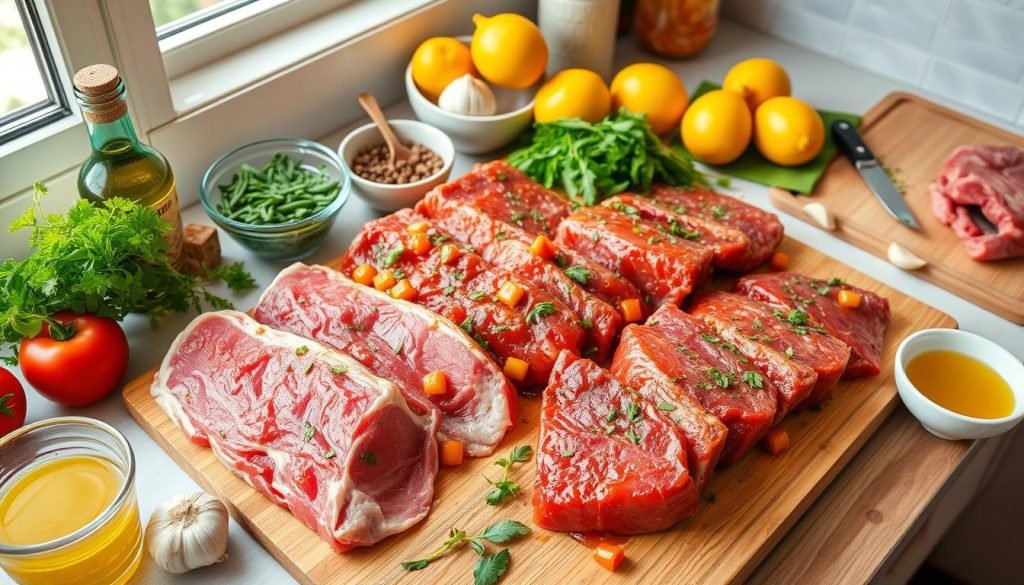
| Protein | Marinating Time |
|---|---|
| Thin cuts of steak (e.g., skirt steak, flank steak) | 2-4 hours |
| Tougher cuts of steak (e.g., top sirloin, sirloin tip) | Overnight (approx. 8 hours) |
| Chicken and pork | 6 hours to 3 days |
| Beef and lamb | 12 hours to 3 days |
| Seafood | 20 minutes to 1 hour |
| Vegetables | 20 minutes to 5 days |
Seasoning Techniques for Flavor Depth
For tasty *barbecue recipes*, seasoning is very important. Start with salt to mix juices and flavors. Add garlic and herbs to make it taste great.
Choose spices and herbs for the taste you want. Smoked paprika and ground cumin add heat. Cayenne pepper gives a strong kick. Mix with oils like olive or avocado for better texture and taste.
Keep meats cold while marinating to stop bacteria. Don’t reuse marinade that touched raw meat. Boil it first if using it as a sauce.
Getting better at *seasoning techniques* takes time and practice. The longer meat sits in marinade, the better it tastes. So, plan ahead for best flavor in your *barbecue recipes*.
Grilling Vegetables: Tips and Tricks
Grilling isn’t just for those who love meat. It makes veggies taste amazing in the summer. Use these tips to get a good char and keep veggies crunchy and flavorful. Your BBQ will turn into a feast that’s both healthy and delicious.
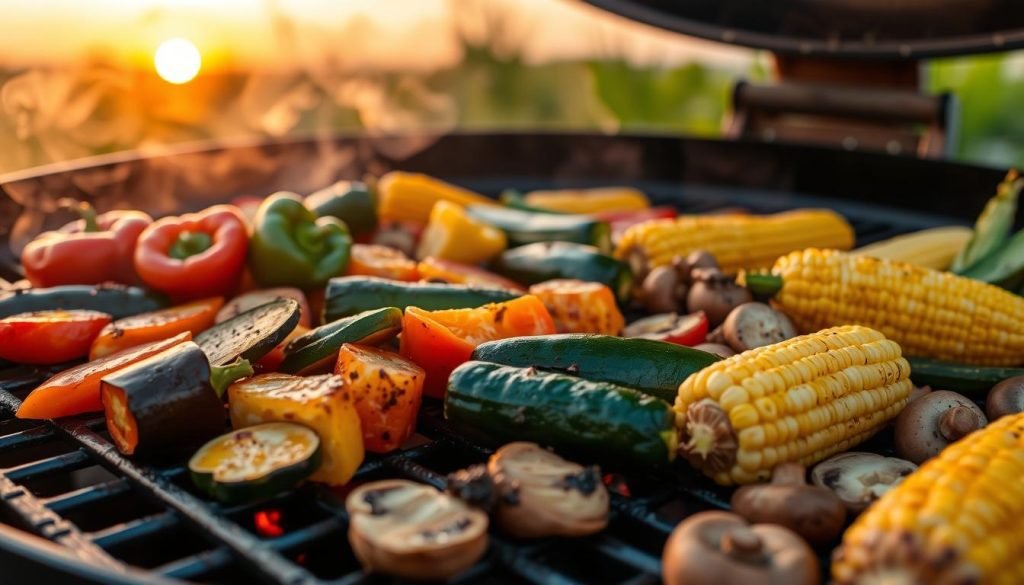
Best Veggies for the Grill
Some veggies shine when grilled. Grill whole veggies like sweet corn, beans, and asparagus with little prep. Veggies like zucchini and eggplant need salting before grilling to stay firm, not soggy.
- Zucchini and eggplant: Salting ahead can prevent sogginess.
- Sweet corn: Grills beautifully directly over flames or after brining for enhanced flavor.
- Bell peppers: High-moisture vegetables that perform best under direct heat.
- Tomatoes: Use varieties with lower moisture content, such as cherry and paste tomatoes, for successful grilling.
Carrots and sweet potatoes grilled whole taste like they’re baked. Cauliflower and Brussels sprouts might need a bit of cooking first to be tender on the grill. The right veggies and prep will make your summer meals better.
Grilling Methods for Success
Knowing how to grill is key. Direct heat works best for watery veggies like bell peppers. For denser vegetables, indirect heat is better. Use one side of the grill for these, especially with charcoal grills or by turning off burners on gas grills.
| Method | Best For | Notes |
|---|---|---|
| Direct Heat | Bell Peppers, Corn | High heat, quick sear, firm texture with char |
| Indirect Heat | Dense Vegetables, Precooked Items | Low heat, slow cook, maintains tenderness without burning |
Using skewers for veggies helps them cook evenly. Group veggies that cook at the same rate together. Keep the grill open for thin veggies and close it for thick ones to cook them well.
Season veggies lightly with salt, pepper, and citrus before grilling to bring out their taste. Marinate them as they cook or right after for great flavor. Use these tips for awesome grilled veggies this summer!
Mastering Different Grilling Techniques
Learning grilling techniques can make you a star at any cookout. You’ll learn how to grill and smoke like a pro. Each way of grilling has its own best use.
Direct vs. Indirect Grilling Explained
Knowing direct grilling from indirect grilling is key. With direct grilling, food cooks right over the fire. It’s great for quick meals like burgers and chicken.
Indirect grilling, however, is for bigger foods. You cook them away from the flames. This slow cooking keeps large meats juicy and tender.
Searing: How to Get That Perfect Crust
For a great crust, use high heat and time it right. Sear meat at 450 to 550°F for 1 to 2 minutes each side. Try reverse searing for even cooking and a nice crust.
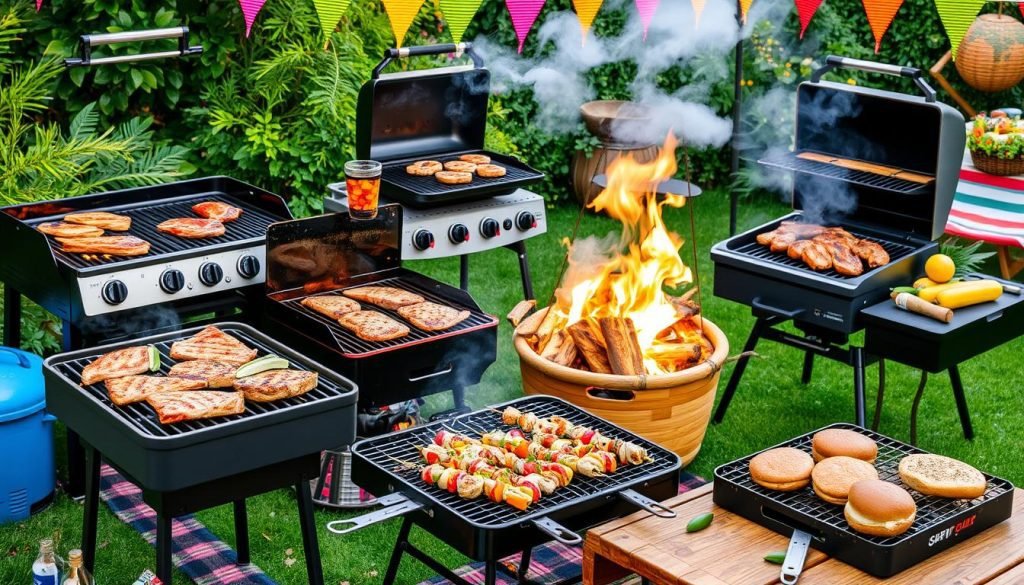
Smoking: Adding Unique Flavors
Smoking adds amazing flavors you can’t get from just grilling. Keep the heat low, under 250°F. Use woods like hickory or apple for special tastes. The 3-2-1 method is good for ribs.
Try out various grilling techniques to improve. Whether it’s direct, indirect, searing, or smoking, each has its magic. They can make your meals amazing.
| Grilling Method | Ideal For | Temperature Range | Key Tips |
|---|---|---|---|
| Direct Grilling | Burgers, Sausages, Chicken Breasts | High Heat | Preheat Grill, Cook Quickly |
| Indirect Grilling | Whole Chickens, Pork Shoulders, Racks of Ribs | Moderate Heat | Cook Slowly and Evenly |
| Searing | Steaks | 450-550°F | 1-2 Minutes Per Side, Reverse Searing for Consistency |
| Smoking | Ribs, Brisket, Fish | Below 250°F | Use Wood Chips for Unique Flavors, 3-2-1 Method |
Grilling for Dietary Needs and Preferences
Grilling can fit many different eating needs, making sure everyone has fun. There are lots of choices for those who eat vegetarian or need gluten-free foods. Let’s look at ways to grill for all kinds of diets.
Vegetarian Grilling Options
Grilling veggies is a great way to enjoy a plant-based meal. You can grill onions, eggplant, peppers, and more. These add great taste and nutrients to any dish.
Grilled peaches add a sweet touch to salads. Grilled scallions make flavors even better.
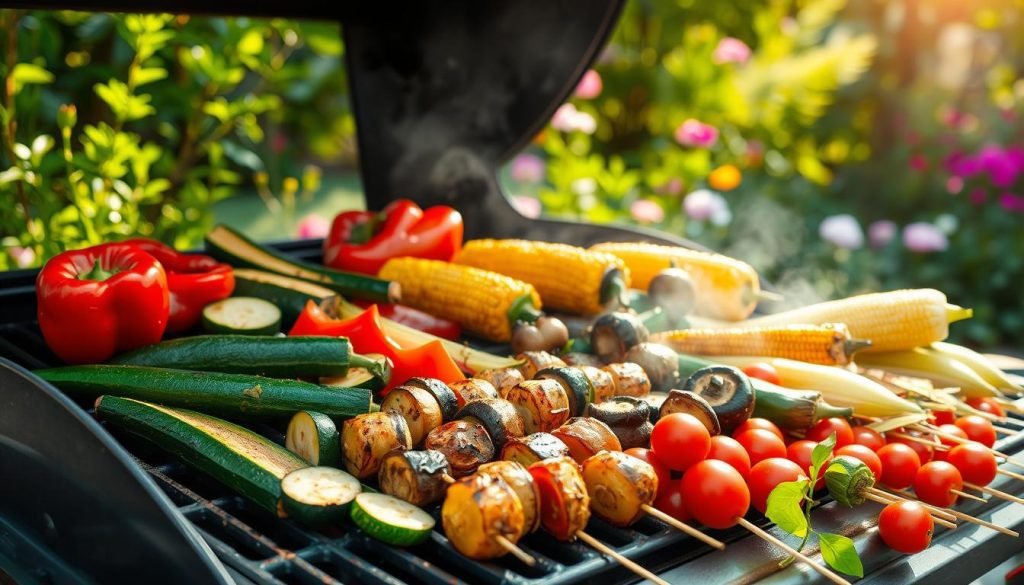
Grilling fruits like watermelon and pineapple makes them sweeter. This is perfect for desserts or drinks. When grilling for health, choosing no-salt marinades makes meals even better.
Gluten-Free Grilling Ideas
Gluten-free grilling is easy with the right plan. Use grilled meats and veggies to make balanced meals. Adding grilled fruits can make your meals more interesting and tasty.
For gluten-free meals, try natural marinades. Grilled peaches are great in salads. You can also add grilled veggies to grain bowls or gluten-free pizzas. This keeps eating fun and safe for those avoiding gluten.
Here’s a simple guide for gluten-free grilling:
| Component | Gluten-Free Options |
|---|---|
| Protein | Salmon, Shrimp, Pork Butt |
| Vegetables | Peppers, Zucchini, Onions |
| Fruits | Grilled Peaches, Pineapple, Nectarines |
| Whole Grains | Quinoa, Brown Rice |
Adding these items to your grilling makes meals tasty and healthy. It’s good for everyone, no matter their diet.
Building the Perfect Grill Menu
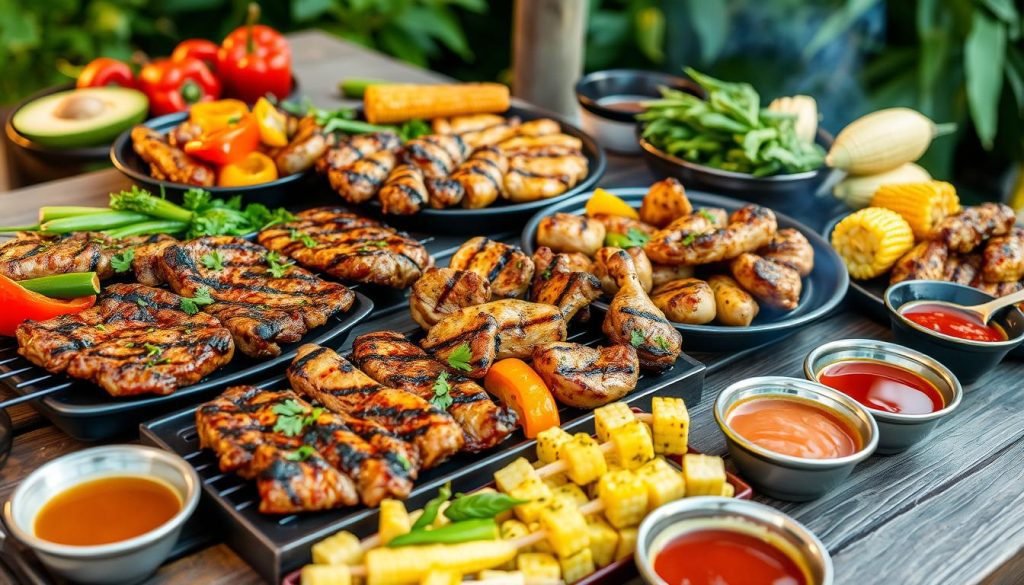
Creating a perfect grill menu involves picking the right meats, sides, and sauces. A great menu has a variety of flavors. It should make everyone happy.
Choosing the Right Proteins and Sides
Proteins are key for any grill menu. You might like pork, chicken, ribs, or some types of seafood. The variety makes sure there’s something for all.
Marinating and air-drying can make your proteins juicier and tastier.
Sides are just as important as meats. Think about grilling veggies like corn or zucchini. They add a nice charred taste. You can also prepare some sides a day ahead. This makes them even more delicious.
Pairing with Sauces and Dips
The right sauces can make your grill favorites taste even better. Try Alabama white barbecue sauce or green harissa. They are famous for adding loads of flavor.
Match your sauces with your dishes. Peach salsa is great with grilled pork chops. Fresh herbs in your sauces can add a nice fresh taste.
| Dish | Total Time | Servings |
|---|---|---|
| Grilled Chicken Recipe | 30 minutes | 4 servings |
| Sweet Corn Recipe | 20 minutes | 4 servings |
| Juicy Lucy Burgers | 30 minutes (plus freezing time) | 4 servings |
| Ribs Recipe | 1 hour 30 minutes | 6 servings |
| Grilled Cake Dessert | 20 minutes | 4 servings |
When making your grill menu, be creative and plan well. A mix of tasty proteins, sides, and sauces will make your grill-out unforgettable.
Hosting a Successful Grill Party
To make a grill party awesome, you need good planning and a fun vibe. Organize your grilling so everything’s ready on time. This way, everyone enjoys themselves to the fullest.
Planning Your Grilling Timeline
First, figure out your grilling timeline. You want all the food ready when your guests are hungry. A BBQ party usually lasts around four hours. Think about how long each food takes to cook.
Begin with chicken and veggies since they take longer. Chicken needs 15-20 minutes. Grill lamb chops later since they cook quickly. Include burgers, hot dogs, and grilled chicken to make everyone happy. Don’t forget veggie options like baked potatoes or skewers.

Add sides like corn, watermelon salad, and baked beans. A variety of sauces will make the food taste even better.
Creating a Friendly Atmosphere
A nice and entertaining setting is key. Make sure there’s comfy seating and music. Fun activities or games help guests mingle and enjoy.
Having a clean bathroom ready is important for comfort. Parties with live music or DJs are loved more because of the great atmosphere.
DIY food stations can make the party more fun, adding a 60% boost in fun. Serve special drinks in reusable cups to be eco-friendly. Using local food helps the planet too.
Fun decorations can make guests 25% more engaged and likely to share on social media. Focus on these tips for a memorable grill party everyone will talk about.
Troubleshooting Common Grilling Problems
Grilling problems can make you upset, especially when you want everything to be perfect. Knowing how to fix common issues is very helpful. From handling grilling troubles to managing flare-ups, here are some tips to solve these issues well.
Dealing with Uneven Cooking
Uneven cooking often happens when the heat isn’t spread out well. Make sure your gas grill’s flame is even, with a blue color and yellow tips. If heat is uneven, it could be from burners blocked by drippings or dirt. Clean your burners or the holes once a year to keep your grill working great.
Regulators can get sticky and limit gas, making the temperature too low. Look at control valves and venturi tubes often, as they’re behind 10 to 20% of grill problems. Fix or clean venturi tubes to stop blockages from bugs or dirt, ensuring the right mix of gas and air.
| Issue | Cause | Solution |
|---|---|---|
| Uneven Heating | Clogged Burners | Clean Burners Annually |
| Low Heat | Sticky Regulators | Inspect Regulators & Control Valves |
| Yellow/Orange Flames | Clogged Venturi Tubes | Clean/Adjust Venturi Tubes |
Fixing Flare-Ups and Charred Food
Flare-ups happen when fats and juices drop onto the burners, making flames jump up. A little flare-up can add a nice smoky taste, but too much can burn your food. This can look bad and be unhealthy.

- Trim extra fat from meats before grilling
- Use a two-zone heating method: direct heat to sear and indirect heat to finish
- Have a water spray bottle ready to put out small flare-ups safely
Doing regular clean-ups stops too much grease from building up, which causes black smoke and flare-ups in about 55% of grills. Clean grill barriers or radiants when they get too greasy. This helps spread the heat evenly. Making these changes will help you handle flare-ups and grill perfect dishes.
Continuous Improvement: Elevating Your Grilling Skills
Grilling is more than just cooking; it’s an art that grows with practice. Picking good meats and the best wood for smoke is key. Every time you grill, you get a chance to get better. Every mistake helps you improve.
Learning from Mistakes: An Encouraging Approach
Don’t let uneven cooking or flare-ups get you down. See them as chances to learn. Getting the perfect sear is hard, but practice makes better. Tools like precision thermometers make it easier. They tell you when the meat is just right. Every cooking method teaches you something new, making you a better griller.
Joining Grilling Communities and Forums
Being in grilling groups and forums helps you learn faster. You can share tips and recipes with other grill lovers. These places are great for learning new things, like wood types or how long to marinate. They make overcoming grilling challenges fun, helping you get better at grilling.